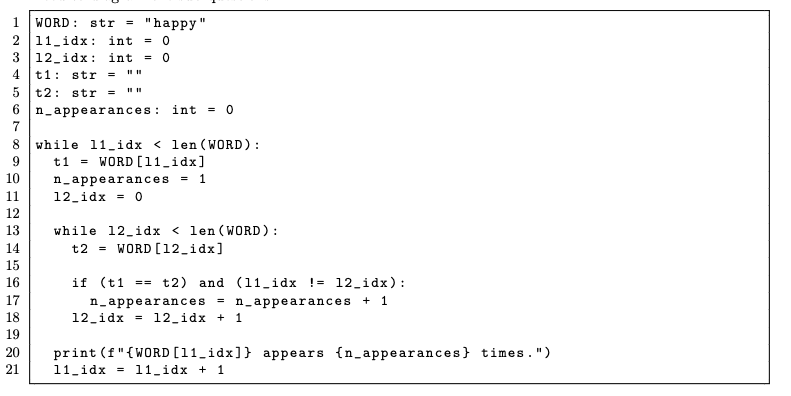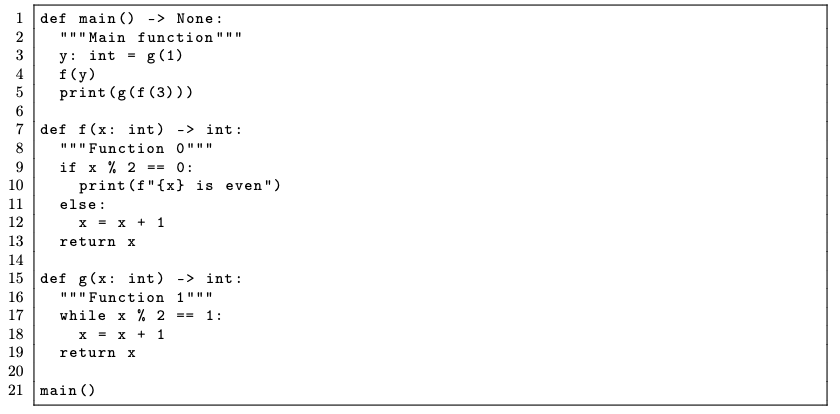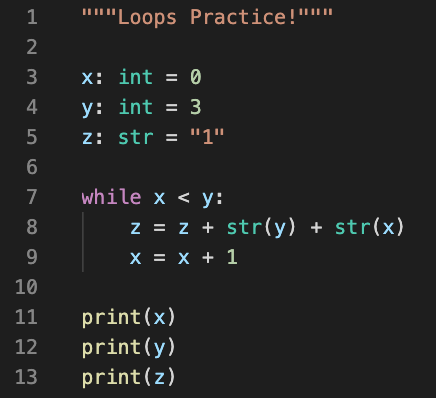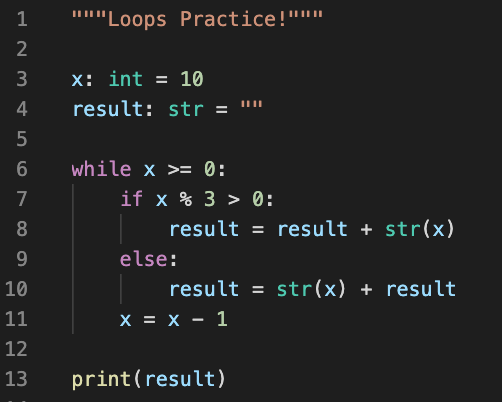These questions are designed to be similar in difficulty (perhaps a bit harder) than the questions on the quiz.
Also remember to look over the concepts listed under Quiz 1 Concepts!
Questions
Memory Diagrams
- Produce a memory diagram for the following code snippet, being sure to include its stack and output.

1.1 What would happen if while l1_idx < len(WORD) in line 8 was replaced with while l1_idx < len(WORD) - 1? Why?
1.2 What would happen if l2_idx=0 was moved to inside the while loop on line 13? In other words, what if lines 11-13 were changed to: 
1.3 What would happen if, in line 16, if (t1 == t2) and (l1_idx != l2_idx): was replaced with if (t1 == t2):? Why?
1.4 What would happen if line 18 was removed? Why?
1.5. What would happen if the < symbol in line 8 was replaced with <=? Why?
- Produce a memory diagram for the following code snippet, being sure to include its stack, heap, and output.

2.1 Why is it that main() is defined above f() and g(), but we are able to call f() and g() inside main without errors?
2.2 On line 5, when print(g(f(3))) is called, is the code block inside of the while loop ever entered? Why or why not?
2.3 What would happen if a line 22 was added that said print(x). Why?
Boolean Operators
- What is the result of the following boolean expressions?
3.1.((not False) and True) == True
3.2.(not False) or (True and False)
3.3.True and (7 < 3 * 4 / 6)
3.4.(not False) != True
3.5.not(True and False) and (False or not False)
While Loops
Given the following code snippet, what is the printed output once it completes?

Given the following code snippet, what is the printed output once it completes?

Solutions
Memory Diagrams
- Solution (We do not require that you write out all interim values as long as the initial and final values are correct like in this solution. However, writing the interim values will help for practice purposes and to avoid mistakes!)
Here’s a link to a video of the solution!
1.1 “y appears 1 times.” would not print. This is because l1_idx will not enter the while loop for l1_idx = 4. (For more practice, it’d be good to diagram this instance out to see how it would impact the final values of other variables.)
1.2 An infinite loop would occur because l2_idx would always equal 1 when returning to the top of the loop, and therefore l2_idx < len(WORD) will always be True.
1.3 If l1_idx != l2_idx is no longer required, this means that each letter can count itself twice. For example, WORD[0] == WORD[0] is true, so n_appearances for "h" would increase to 2.
1.4 There would be an infinite loop because l2_idx will never increase, and therefore l2_idx < len(WORD) will always be True.
1.5 There would be an index error because there would be the case where l1_idx = 5, so on line 9 WORD[5] would be searching for the element at index 5 in "happy", when the indexes only go up to 4.
2.1 Even though main is defined before f and g, it isn’t called until after f and g are defined.
2.2 No because x = 4, so x % 2 == 1 is False, and therefore the code block inside is never run.
2.3 There would be an error because x is a local variable inside both f and g. In other words, x is NOT a global variable. Therefore, the program does not recognize that x exists in this context.
Boolean Operators
- 3.1.
True
3.2.True
3.3.False
3.4.False
3.5.True
Conditionals
- False
- False
- False
- 7.1. 16.0
7.2. 2.0
7.3. -3.0
7.4. 3.0
7.5. 1
While Loops
- 3
3
“1303132” - “036910875421”